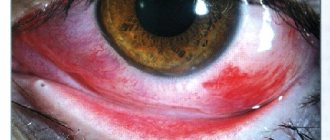Conjunctivitis often develops due to poor hygiene, so children are more likely to get it. It also occurs in adults. Treatment methods for this disease differ slightly among different age groups. Age is one of the factors taken into account when selecting medications. How to treat conjunctivitis in adults? Let's consider methods of combating this disease.
In this article
- How is conjunctivitis treated in adults?
- Why does conjunctivitis occur in adults?
- The nature of the development of conjunctivitis
- How is bacterial conjunctivitis treated?
- Acute conjunctivitis: treatment
- How to treat viral conjunctivitis?
- Adenoviral conjunctivitis: treatment in adults
- Treatment of allergic conjunctivitis
- General principles of treatment of conjunctivitis
How is conjunctivitis treated in adults?
Conjunctivitis is an inflammatory lesion of the conjunctiva, which is also called the connective membrane of the eye. Many eye diseases are reflected precisely in the state of this structure of the eyeball. It is an outer covering that protects the inner parts of the eye from external influences. In addition, the conjunctiva performs a secretory function, helping to moisturize the surface of the cornea. Any pathology affecting the connective membrane prevents the eyes from functioning normally. One of the most common diseases of the conjunctiva is conjunctivitis. Almost 70% of the population suffer from it or have had it at least once in their lives.
How is conjunctivitis treated, and how dangerous is this disease for the eyes? If treatment is prescribed in the first days of the illness, the patient is guided by all the doctor’s instructions and no unpredictable situations arise, then the inflammation goes away quite quickly, in a week or two. In some cases, the disease drags on.
This usually becomes a consequence of untimely prescribed therapy or a person’s irresponsible attitude towards their health. Many patients continue to go to work and stop taking medications, as a result of which conjunctivitis becomes chronic. Let's take a closer look at this pathology, find out its causes, symptoms, and types. Next, we will analyze the methods used to treat adult patients with conjunctivitis.
"Floxal"
The active component in the drug is ofloxacin, a substance that has a pronounced effect against microbial activity. It is noticeably effective even in the treatment of infectious diseases caused by microorganisms resistant to most antibiotics and sulfonamide drugs. The course of therapy is two weeks, then you need to visit an ophthalmologist. You can also use Floxal eye drops, alternating with a similar ointment. With this method of treatment, you should follow the scheme: first drops, then ointment.
Why does conjunctivitis occur in adults?
In children and adults, conjunctivitis occurs for the same reasons. Direct causative agents of inflammation of the eye mucosa are bacteria, viruses and fungi: staphylococci, gonococci, adenoviruses, herpes, etc.
It can also be caused by allergies. Sometimes the inflammatory process develops due to exposure to chemicals in the eye. These are the main factors that can cause connective membrane disease. There are also indirect reasons - a group of factors that increase the risk of developing conjunctivitis. These include:
- diseases and conditions that negatively affect the immune system;
- refractive defects - astigmatism, myopia, hypermetropia, presbyopia;
- ophthalmopathology of infectious or viral etiology - blepharitis, keratitis, keratoconjunctivitis;
- poor hygiene, including when using contact optics;
- mechanical injuries to the eyeballs, penetrating wounds;
- viral infections - influenza, measles, acute respiratory viral infections, acute respiratory infections, herpes;
- vitamin A deficiency, which makes the visual organs more vulnerable to environmental conditions;
- food and drug allergies;
- venereal diseases;
- use of low-quality cosmetics;
- frequent unsystematic use of eye drops.
During diagnosis, the doctor tries to determine the cause of the disease, its type and form. It depends on them how and with what they will have to treat conjunctivitis.
Aktipol
Actipol drops for conjunctivitis are suitable for advanced stages of the disease. "Aktipol" not only treats conjunctivitis, but also strengthens local immunity. Often these eye drops are prescribed for ARVI and herpes. "Aktipol" also helps relieve inflammation in case of minor eye bruises and damage to the mucous membrane in those who wear lenses. You need to drip Actipol into your eyes 3 to 8 times a day. The drug helps to completely cure conjunctivitis in a week or two. The main active ingredient of these eye drops is para-aminobenzoic acid, which strengthens local immunity, thanks to which the body independently resists viruses. "Aktipol" can be used by pregnant women in the second and third trimester.
Aktipol
Diapharm, Russia
Actipol is an ophthalmic antiviral agent that is an inducer of endogenous interferon.
In addition to the antiviral effect, it has antioxidant and regenerative properties. from 232
526
- Like
- Write a review
The nature of the development of conjunctivitis
According to the form of its course, this disease is divided into acute, chronic, purulent, catarrhal, follicular, membranous. The nature of the development of the disease is determined by the number and intensity of symptoms. Acute conjunctivitis is characterized by pronounced symptoms.
The first signs appear within a day or two after a person is infected with bacteria, which most often cause this form of inflammation. Acute bacterial conjunctivitis is almost always purulent, that is, accompanied by the release of pus in a large volume. The chronic type of inflammatory process manifests itself moderately. The patient's eyes quickly become tired, the conjunctiva becomes noticeably red, and lacrimation is bothersome.
Catarrhal, follicular and membranous forms of conjunctivitis are observed in viral infections - adenoviral and herpetic. Inflammation of the catarrhal type passes without complications; within a few days after taking antiviral drops, the symptoms of the disease disappear. Follicular and membranous forms of conjunctivitis can be considered complicated. In the first case, the formation of follicles - accumulations of lymph or blood - is observed on the mucous membrane of the eye, and with film inflammation, grayish films appear on the connective membrane.
These are the main forms of conjunctivitis. In some cases they are also stages. The longer a visit to the doctor is delayed, the more severe the illness becomes. The risk of complications increases. Treatment methods for conjunctivitis are determined not only by the nature of its development, but also by the type of inflammation. The most common of them are bacterial, viral, fungal, and allergic. We list their main symptoms and methods of treatment.
"Sofradex"
A potent drug containing several antibiotics at once - dexamethasone, gramicidin and framycetin. It should not be used for more than seven days. When instilled into the eyes, it relieves burning, lacrimation, and photophobia. Each of the components has its own pronounced effect.
Framycetin sulfate is an antibiotic from the aminoglycoside group. It has an extended antibacterial effect, is active against most gram-negative organisms (Escherichia coli, dysentery, Proteus and others), as well as gram-positive microorganisms, including Staphylococcus aureus. However, framycetin does not have a suppressive effect on pathogenic fungi, streptococci.
Gramicidin expands the spectrum of antimicrobial action of framycetin due to its activity against streptococci and anaerobic microorganisms. Strengthens the reaction of framycetin against staphylococci, as it also has an antistaphylococcal effect. Dexamethasone neutralizes inflammation by inhibiting mast cell migration and reducing capillary permeability.
How is bacterial conjunctivitis treated?
Inflammation of the ocular mucosa caused by bacteria is usually acute. The causative agents of the disease are staphylococci, streptococci, gonococci, pneumococci, Pseudomonas aeruginosa and other microbes.
Any acute conjunctivitis of bacterial origin is accompanied by the following symptoms:
- mucous and purulent discharge;
- severe itching and burning in the eyes;
- a feeling that a foreign body has entered under the eyelids;
- tearfulness;
- painful reaction to light;
- pain in the eyeballs when moving them;
- swelling and hyperemia of the conjunctiva and eyelids.
First, all these signs appear on one eye, and after a day or two - on the second. In rare cases, it is possible to avoid infection of a bilateral nature. Much depends on the patient's compliance with hygiene rules.
Other symptoms of the disease may also be observed. Some of them can help determine the cause of inflammation. With pneumococcal infection, red dots are observed on the conjunctiva, which indicate hemorrhages. With staphylococcal conjunctivitis, a lot of pus is released. The eyes have to be washed with special solutions several times a day. Mucous and purulent masses accumulate and flow over the eyelids.
Gonococcal inflammation of the eyes in adults is diagnosed extremely rarely. It usually occurs in newborns who become infected with gonococci from the mother while passing through the birth canal. Diphtheritic conjunctivitis is also usually detected in childhood, which develops against the background of diphtheria. Streptococcal infection also occurs in adults. Sometimes it occurs as a result of the spread of infection from the upper respiratory tract.
Acute bacterial conjunctivitis is highly contagious. It can be contracted through household contact. Bacteria live almost everywhere. You can accidentally get them into your eyes with dirty hands. For this reason, it mainly affects children who pay less attention to hygiene. Treating bacterial conjunctivitis in children and adults requires different medications. The former are less likely to be prescribed antibiotics. Otherwise, the principles of treatment are similar. What are they?
Ciprofloxacin-Optic
Ciprofloxacin-Optic drops are an inexpensive broad-spectrum antibiotic that copes well with purulent conjunctivitis. These eye drops are odorless and come in a glass bottle. Dosing the drug is very convenient thanks to the narrow spout-tip. Literally a day after using Ciprofloxacin, pus stops coming out of the eyes, and after three days of treatment, conjunctivitis completely disappears. Eye drops do not “harm” the eyes, and patients note a rapid recovery: swelling of the eyelids, inflammation and burning in the eyes disappear. If you want to quickly cure conjunctivitis, use Ciprofloxacin drops, strictly following the instructions.
Ciprofloxacin-Optic
OJSC Pharmstandard-Leksredstva, Russia
Treatment of corneal ulcers and infections of the anterior segment of the eyeball and its appendages caused by bacteria sensitive to ciprofloxacin in adults, newborns (from 0 to 27 days), infants and infants (from 28 to 23 months), children (from 2 to 11 years) and teenagers (from 12 to 18 years old).
from 44
192
- Like
- Write a review
Acute conjunctivitis: treatment
Treatment of conjunctivitis in adults, if it occurs in an acute form and is caused by bacteria, is necessary with the help of antibiotics and drugs with antibacterial action. Ciprofloxacin, Ofloxacin, and Levomycetin are usually prescribed. All these products are prescribed in the form of ointments and eye drops. If the inflammation is caused by gonococci and meningococci, injections are given intramuscularly. Such infections are quite rare. The need for injections arises because these types of bacteria almost immediately affect the functioning of the visual system. Administration of topical antibiotics may have no effect.
Treatment of adults with medications of this type, as a rule, does not cause complications. It is not always possible to predict the reaction of a child’s body to antibiotics, so they are prescribed to children only when the disease is severe.
If the patient consults a doctor a day or two after the first symptoms of conjunctivitis appear, he will not have to be treated for long. Depending on which bacterium caused the inflammation, treatment lasts 7-14 days.
Visine Classic
These American-made eye drops are great for patients with allergic conjunctivitis. Literally 5-7 minutes after instillation, the condition of the eyes noticeably improves. The positive effect after Visin Classic lasts 4-8 hours. Visin Classic drops for conjunctivitis relieve inflammation, dry mucous membranes, swelling and redness if they are caused by wearing lenses, a reaction to dust and cosmetics, or chemical irritants. Visin Classic can be used in children from 2 years of age, but only if there are indications for this (inflammation and swelling). Allergic conjunctivitis with proper use of the drug goes away in 3-4 days.
Visine Classic
How to treat viral conjunctivitis?
Often, the causative agents of viral conjunctivitis are herpes and adenoviruses. The first type of inflammation can be determined simply by such a characteristic sign as the formation of blisters on the eyelids. They cause itching, burning, lacrimation, blepharospasm, swelling, redness. Herpetic conjunctivitis can lead to blurred vision. Most often this happens because the patient ignores the symptoms. When a viral herpetic infection develops, he continues to go to work, does not go to doctors, and therefore does not use medications or uses drugs that are in the home medicine cabinet. The lack of proper treatment can lead to conjunctivitis being complicated by another eye disease, for example, bacterial inflammation, keratitis or blepharitis. As a result, the inflammatory process moves from the conjunctiva to other structures of the eye, including the cornea. This is almost always accompanied by a decrease in visual acuity. How to treat conjunctivitis caused by the herpes virus?
The fight against this type of disease is carried out with the help of anti-inflammatory and antiviral drugs: “Riodoxol”, “Acyclovir”. Antiherpetic ointments are also prescribed: Florenal, Acyclovir, Virolex. The bubbles are treated with a brilliant green solution.
Diclofenac
Diclofenac eye drops relieve inflammation in conjunctivitis and are prescribed after injuries and eye surgeries to reduce pain. The active ingredient of the drug is diclofenac sodium, which, due to its rapid absorption into the blood, instantly relieves unpleasant symptoms. Use Diclofenac drops strictly according to the instructions, since the drug has contraindications and side effects (allergies, itching, swelling, nausea and vomiting). An opened bottle of Diclofenac can be stored for a month.
Diclofenac drops
Sintez OJSC, Russia
Has anti-inflammatory and analgesic effects.
In inflammatory processes that occur after operations, it relieves pain and reduces inflammatory swelling at the wound site. from 20
5.0 1 review
79
- Like
- Write a review
Adenoviral conjunctivitis: treatment in adults
This type of inflammation occurs as a secondary disease that develops against the background of a viral infection. First, a person becomes infected, for example, with ARVI, and then accidentally introduces viruses into the eye, which leads to an inflammatory process. The first symptoms of the disease are characteristic of all viral infections:
- weakness and drowsiness;
- fever and chills;
- runny nose;
- cough;
- headache.
After a few days or a week, signs of conjunctivitis begin to appear: lacrimation, itching, burning, etc. Unlike bacterial inflammation, viral inflammation is not accompanied by purulent discharge. The formation of a mucous film on the surface of the eye is observed.
Viral conjunctivitis is treated with antiviral drops. Antibacterial agents are also prescribed. They are necessary to prevent a bacterial infection from joining the underlying disease.
Montevisin
Eye drops for conjunctivitis "Montevisin" are excellent value for money. This is a kind of “first aid” for conjunctivitis, when you need to quickly get rid of symptoms. Drops instantly relieve eye fatigue, pain, pain, swelling and redness. A few minutes after instillation, the vascular network is no longer so visible, the view becomes clearer. But Montevisin has a number of contraindications associated with high blood pressure and heart disease, so be sure to consult your doctor. Thanks to the convenient pipette, it is very convenient to use Montevisin eye drops.
Montevisin
Swelling of the conjunctiva, secondary hyperemia in allergic eye diseases, irritation of the conjunctiva;
- hyperemia and/or swelling of the conjunctiva caused by various nonspecific causes (condition after tonometry, dust, cigarette smoke, smog, swimming, reading, driving). from 132
355
- Like
- Write a review
Treatment of allergic conjunctivitis
Allergies are usually a chronic pathology. But allergic conjunctivitis always occurs in an acute form. Many people mistakenly believe that it is seasonal. However, it can occur at any time of the year; the risk of the disease simply increases in the spring and summer. In case of an allergic reaction, severe itching immediately appears in the eyes. This type of inflammation is also characterized by uncontrollable lacrimation, photophobia and burning.
When treating, the first step is to identify the allergen and eliminate contact with it. Antihistamines are prescribed to relieve inflammation. In severe cases, glucocorticosteroids are used. Immunotherapy is always performed. An allergy is a consequence of the immune system perceiving a substance as hostile. Strengthening the immune system helps eliminate symptoms of the disease and recovery.
Diagnostics
To diagnose conjunctivitis, it is enough for an experienced specialist to conduct an external examination of the eyes. It is much more difficult to determine the nature of the inflammation, so additional research may be required to determine the cause of the disease:
- Blood and urine analysis;
- Collection and examination of eye secretions;
- Culture of material obtained from a smear;
- Analysis of antibodies in blood serum;
- Allergy diagnosis – contact with the suspected allergen and analysis of the body’s reaction.
General principles of treatment of conjunctivitis
For all forms and types of this disease, moisturizing drops based on natural tears are prescribed. Their advantage is that they have a gentle effect and do not cause side effects even for allergy sufferers. Such drugs (Systane, Artificial tear) are suitable for adults and children.
When treating conjunctivitis, it is necessary to carefully observe the rules of hygiene. Apart from allergies, all the other diseases listed are highly contagious. You can avoid re-infection, infection of both eyes at once and the spread of infection in the family using the following preventive measures:
- wash your hands thoroughly with soap, especially after interacting with a sick person or contacting his things;
- Boil pipettes and ointment sticks every evening;
- use disposable napkins and utensils;
- Do wet cleaning at home every day and ventilate the room more often;
- After recovery, do not use contact lenses that you wore before your illness.
If you consult a doctor on time and during treatment follow all the previously listed rules, conjunctivitis will go away quickly and will not cause complications.
Opatanol
Drops for conjunctivitis "Opatanol" produced in Belgium are used for the allergic nature of the disease. "Opatanol" is intended for adults and children over 3 years old. These drops are also suitable for pregnant women. To treat allergic conjunctivitis, you need to use these eye drops 2 times a day, but do not forget to shake the bottle before each drop. Opatanol is well tolerated and has almost no side effects. The active substance of the drug is olopatadine hydrochloride, which triggers anti-allergenic mechanisms.
Opatanol
Alkon, Switzerland
Opatanol - decongestant and antiallergic eye drops for use in ophthalmology.
from 352
484
- Like
- Write a review
Etiology of CD
CD most often develops in healthy individuals. Risk factors for the disease have been identified:
- contact with infected people;
- non-compliance with the rules for using contact lenses;
- sinusitis;
- immunodeficiency states.
According to a group of researchers from Riyadh, Saudi Arabia, led by Hammouda Ehab, published in the European Journal of Ophthalmology in 1999, the most common causes of CD are:
- Staphylococcus aureus, S.epidermidis, S.pneumonie, S.viridans;
- Haemophilus influenzae;
- Streptococcus pneumoniae;
- Moraxella spp.
In rare cases, CD is associated with Neisseria gonorrhoeae and Chlamydia trachomatis. People who are sexually promiscuous are at risk for chlamydial and gonococcal CD.
Chronic CD is most often observed during infection with Staphylococcus aureus, Moraxella lacunata, bacteria of the Enterobacteriaceae family; Chlamydia trachomatis.
Scheme 1. Procedure for diagnosing conjunctivitis
Pathogenesis of CD
There are four physiological barriers to infection of the conjunctiva:
- epithelial layer covering the conjunctiva;
- hematological immune mechanisms operating in the vessels of the conjunctiva;
- immunoglobulins and lysozyme contained in the tear film;
- “washing” effect from blinking and lacrimation.
The vulnerability of one or more barriers, for example, decreased tear production, damage to the epithelial layer of the conjunctiva, eye injury, decreased immune response, etc., creates favorable conditions for the development of CD.
CD can develop through contact with contaminated water, towels, bed linen, etc. Infection of newborns with chlamydial and gonococcal conjunctivitis occurs during passage through the natural birth canal. Another option is an abnormal proliferation of microorganisms of the normal flora of the conjunctiva. As for the question of whether bacterial conjunctivitis is contagious or not, given the ways the disease spreads, the answer will be positive, so it makes sense to limit contact with patients.
In children, CD is most often caused by:
- Haemophilus influenzae;
- Streptococcus pneumoniae;
- Moraxella catarrhalis1
The superficial tissues of the eye are colonized by normal flora, including strains of coagulase-negative staphylococci, streptococci, Corynebacterium and other microorganisms. Changes in the immune defense can lead to overgrowth of bacteria that normally inhabit the conjunctiva and the development of CD.
Scheme 2. Main symptoms of bacterial conjunctivitis











